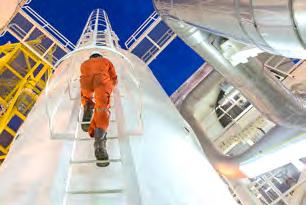FOCUS SAFETY
Lessons learned
By SAM BARNES
Seasoned South Louisiana EHS leaders share emerging best practices in safety.
S
afety in the industrial space has been altered, perhaps permanently, by COVID-19. In the early days of the pandemic, safety leaders had to
quickly pivot—often with little official guidance or information— to address a safety threat with unknown potential. After more than a year of changing policy and evolving risks,
along with significant investments in masks, sanitizing products and other measures, many of these policies have coalesced around a handful of central guiding principles. 10/12 Industry Report sat
down with a few of south Louisiana’s seasoned safety leaders and asked them to reflect upon the challenges of the last year, and to discuss how they now approach safety on a daily basis.
The COVID-19 pandemic has been undeniably impactful to the safety environment in 2020-21. How has it impacted your daily schedule and the way you now approach safety in the field?
DAVID MIHALIK Director of Environmental, Health, Safety, Medical and Security BASF, Geismar
MIHALIK: BASF’s pandemic planning had been in place since the mid2000s with the arrival of H1N1 and the bird flu. We understood at some point a virus could emerge that would challenge the way we protect our team members and our workplace, and we were prepared to deal with it. What we did not anticipate or expect when we put the COVID protocols into place was just how long it would last. SATTERFIELD: Dealing with the virus has resulted in our site and company creating additional safety measures for our teams to keep our site and employees safe. Over the last 18 months, we have spent a significant amount of time dedicated to the health and safety of our workforce. While it has always been a priority for our company, the COVID-19 pandemic has created a whole new layer to our health and safety protocols and brought additional challenges to managing the health and safety of our personnel. WARD: Over the past few years, safety in the industrial workplace has continued to evolve with new challenges, new technologies and new processes to continue to drive our zero injury and incident goals. The most recent challenge, of course, has been the response to the COVID-19 pandemic. We have pandemic plans in place as part of our emergency management procedures; however, even the best plans must be adjusted to address unique situations, not the least of which is an evolving pandemic.
GREG SATTERFIELD Senior Safety Engineer LyondellBasell, Westlake
What have been some of the specific challenges posed by COVID-19? And solutions? MIHALIK: BASF was prepared with a plan, but we recognized early on that the amount of safety supplies we had stockpiled would not sustain us for very long. This was due, in large part, to a supply chain that did not have enough inventory and struggled to supply the needs of even the health care industry. That meant we were forced to come up with alternative methods and materials to ensure safety protocols were being met at the sites until the supply chain and inventory could catch up to demand.
SHAWN WARD Director of Corporate Health, Safety, Security, Environment and Sustainability Cornerstone Chemical, Waggaman
52 10/12 INDUSTRY REPORT • FALL 2021
WARD: COVID-19 has taken workplace response planning to a whole new level to ensure the health and safety of everyone at our site. From enhanced monitoring and screening processes to appropriate PPE, to how we meet with one another to conduct business―all of these had to be reassessed and designed to ensure employee health and safety. Following Centers for Disease Control guidelines and other best practices to keep employees safe and healthy amidst a pandemic has been a real learning curve, but it has also inspired new ideas and approaches to pandemic response and exposure prevention, including enhancing work stream efficiencies and safely minimizing potential for exposure during the work day. Throughout the pandemic, we have continued to increase and refine our industrial hygiene practices and procedures onsite, and we have made sure to update those aspects of our regular workplace safety programs. 1012industryreport.com







